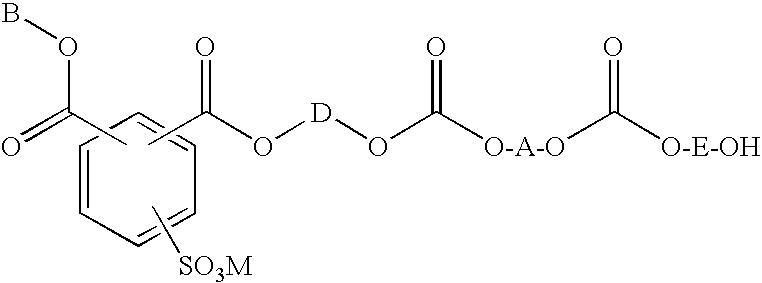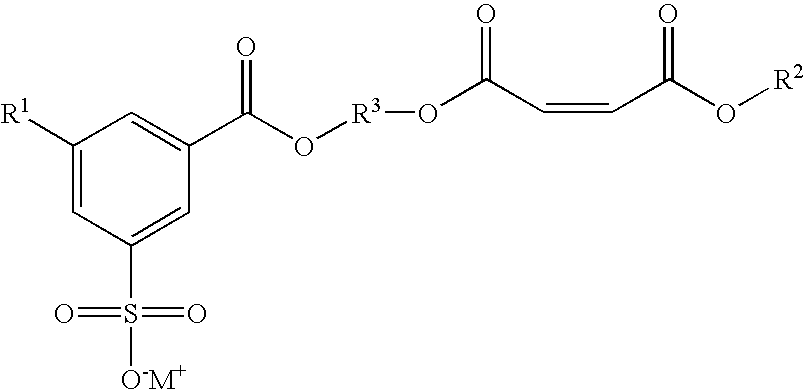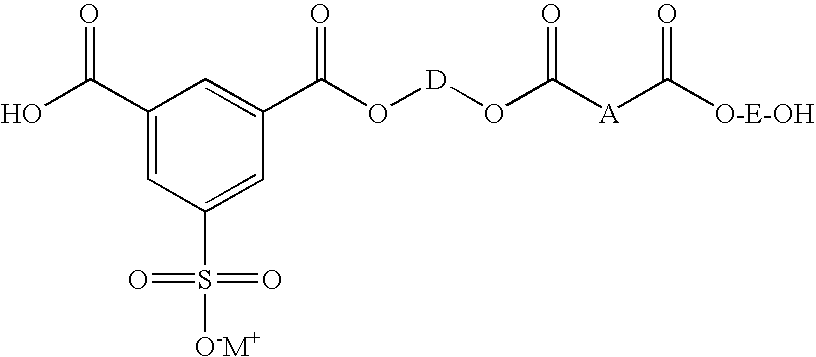Compositions and methods for treating textile fibers
a technology of textile fibers and compositions, applied in the direction of dyeing process, liquid repellent fiber, transportation and packaging, etc., can solve the problems of significant energy and water consumption, and achieve the effect of reducing energy and water consumption and lessening the overall environmental footprint of fiber treatment processes
- Summary
- Abstract
- Description
- Claims
- Application Information
AI Technical Summary
Benefits of technology
Problems solved by technology
Method used
Image
Examples
example 1
Application of an Aqueous Composition to a Fibrous Substrate
[0067]An aqueous composition of the present invention was prepared for application to nylon 6 carpet fibers by adding to a mixing tank 10 g of a C6 acrylate fluoropolymer dispersion available from Peach State Labs of Rome, Ga. as Sartech 13-60 per liter of distilled water in the mixing tank. 18.75 g of a polyester stain resistant chemical species available from Peach State Labs as Myalon SBLC were also added per liter of distilled water in the mixing tank. A sufficient amount of urea sulfate was added to the aqueous composition comprising the acrylate fluoropolymer and polyester stain resistant chemical species to bring the pH of the aqueous composition to 1.9.
[0068]The aqueous composition was subsequently injected with a sufficient amount of light tan acid dye in route to application to the nylon 6 carpet fibers by a Kuster type Fluidyer at 400% wet pick up. The treated nylon 6 carpet was subsequently steamed for about 3.5...
example 2
Application of an Aqueous Composition to a Fibrous Substrate
[0069]An aqueous composition of the present invention was prepared for application to nylon 6 carpet fibers by adding to a mixing tank 5.6 g of a C6 acrylate fluoropolymer dispersion available from Peach State Labs of Rome, Ga. as Sartech 13-60 per liter of distilled water in the mixing tank. 13.3 g of a polyester stain resistant chemical species available from Peach State Labs as Myalon SBLC were also added per liter of distilled water in the mixing tank. 5.1 g of urea sulfate per liter of distilled water in the mixing tank were added to the aqueous composition comprising the acrylate fluoropolymer and polyester stain resistant chemical species to bring the pH of the aqueous composition to 1.68.
[0070]The aqueous composition was subsequently injected with a sufficient amount of light tan acid dye in route to application to the nylon 6 carpet fibers by a Kuster type Fluidyer at 450% wet pick up. The treated nylon 6 carpet wa...
example 3
Oil Repellency and Stain Resistance Testing of Examples 1 and 2
[0071]The treated nylon 6 carpet compositions were tested for repellency and stain resistance according to the following protocols. Repellency was measured by floating the treated carpet compositions of Examples 1 and 2 back side down in a Kool Aid (with sugar) solution at 75° F. for 5 minutes. A pass rating was assigned if the treated carpet sample floated with only fibers on the back of the sample contacting the solution. A marginal rating was assigned if the treated carpet sample sank in the solution up to half the fiber height on the face of the sample. A fail rating was assigned if the treated carpet sample sank in the solution prior to expiration of the 5 minutes.
[0072]Stain resistance was determined according to observations of residual Kool Aid stain (with sugar) made subsequent to applying a solution of Kool Aid (with sugar) at 140° F. to the treated nylon 6 carpet samples from a height of 1 foot and allowing th...
PUM
| Property | Measurement | Unit |
|---|---|---|
| concentration | aaaaa | aaaaa |
| concentration | aaaaa | aaaaa |
| acid | aaaaa | aaaaa |
Abstract
Description
Claims
Application Information
 Login to View More
Login to View More - R&D
- Intellectual Property
- Life Sciences
- Materials
- Tech Scout
- Unparalleled Data Quality
- Higher Quality Content
- 60% Fewer Hallucinations
Browse by: Latest US Patents, China's latest patents, Technical Efficacy Thesaurus, Application Domain, Technology Topic, Popular Technical Reports.
© 2025 PatSnap. All rights reserved.Legal|Privacy policy|Modern Slavery Act Transparency Statement|Sitemap|About US| Contact US: help@patsnap.com



